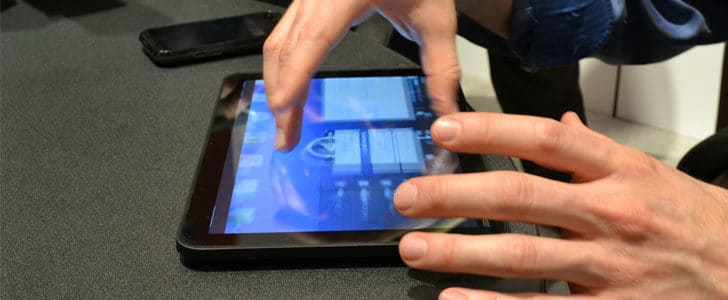For decades many mobile handset manufactures tried to make full touch screen device, yet they failed when it reach the retail market. The reason was the quality of touch responsiveness and speed of transition was way behind compared to real touch. But once Apple introduces the very first iPhone, it dominated the market like flash.
If you take a closer look in to specification, you will be surprised. It’s only 2G and no multitasking etc, but with in very short time it surpasses all the other features rich devices. The secret here is Touch responsiveness. Due to that Apple could remove all the buttons from iPhone and keep only the home button. Any average person could use iPhone with its touch responsive screen same way they interact with real life objects. Down the time they further improve it and today we have iPhone 4S and 3rd generation iPad too.
With the time Google Android, an open source project also came in to picture with full touch mobile handsets. They had three buttons for back, home and settings and they may differ depending on manufactures UI design.

If you compare iOS with Android, no doubt that you will notice Android is far more features rich. Even if you compare Android 2.3 Ginger Bread and latest iOS 6 still android is far ahead. Then why still android failed to reach general public like iOS. Part of the reason is promotion, but the major reason is touch responsiveness.
Touch Responsiveness in iOS and Android
True that android is features rich but if you solely compare the touch responsiveness iOS is far ahead. Touch lag is negligible and a general user would say that there is zero touch lag. Transitions are super smooth and feel like touching and move a real life object.
When it comes to android, there is a noticeable touch lag and sometimes it’s even higher due to manufacture developed themes. If you take a closer look you will see transitions are choppy and less responsive. Even if you try out latest dual core or quad core handset still it’s far behind from iOS handset.

Reason for Android’s Less Responsive Touch
iOS is carefully engineered to work with one specific type of hardware platform. iOS developers know in and out of iPhone’s hardware architecture and thoroughly optimize their source code to get maximum out of it. All the development technology they are using is also light weight and highly performance tuned. In addition they have given top priority to the rendering engine and full power of CPU and GPU to make transitions smooth by giving lesser priority to other tasks. That’s why for a long time they didn’t support multitasking and still they do only partially.
In Android all the factors are other way around. It’s working on various different hardware platforms and source code is generalized for each. Some of the development tools are also performance consuming and laggy such as JAVA. Further as far as I know rendering engine is not getting any special priority in CPU. Therefore touch lag is significant and transitions are not smoother. If you are using Kindle like eBook reader you can see frames are getting refreshed with just naked eye when you flip pages.
What is Project Butter?
After identifying this major performance bottle neck in Android OS, they initiated a research project to reduce the touch lag and make the transition smoother by increasing frame rate in UI. The project was named as Butter highlighting its objective of butter smooth UI.

The result of project butter came out with latest version of Android which is Jelly beans. They have increased frame per second in UI up to 60 by introducing Triple buffering and simultaneous CPU and GPU processing. Outcome is just amazing and you will be able have butter smooth android experience like never before. This level of performance has been achieved by totally revamping Android rendering engine.
If you compare touch lag and transitions in iOS and Android experience would be exactly identical. This is a huge step in Android roadmap. Android is anyway having better features and customizability than iOS and now, it’s having butter smooth touch responsiveness as well.
Project butter is one critical milestone in Android and removed one last limiting factor for it to compete with iOS. War is on, iOS and new and bigger Android facing each other head on. Let’s sit back and enjoy the show.
Tags: #Android #Jelly Bean
